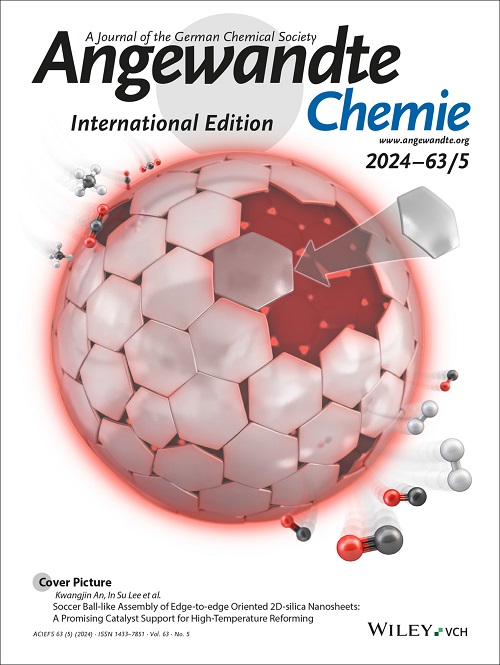二维共价有机框架的级联金属化促进电化学二氧化碳还原
IF 16.1
1区 化学
Q1 CHEMISTRY, MULTIDISCIPLINARY
引用次数: 0
摘要
由于一氧化碳还原反应(CORR)具有较大的过电位,因此需要对催化剂进行精细设计,以产生高附加值的甲醇。特别是,在保持活性位点周期性排列以优化性能的同时实现电催化剂的精确改性仍然是一项重大挑战。在此,我们报告了对酞菁基 COF 进行级联金属化以选择性还原 CO 到甲醇的过程。在植入二级金属(镍)后,CityU-35 在 -0.85 V 对 RHE 时的法拉第效率(FE)达到 48.4%,超过了仅含有 Co 原子的 CityU-34(2.1%)。紫外和 X 射线光电子能谱中的光谱偏移以及原位衰减全反射表面增强红外吸收光谱(ATR-SEIRAS)中更强的 *CO 信号证实了这一点。理论计算表明,在 CityU-35 中引入二级镍位点的级联金属化不仅能改善对 *CO 中间体的吸附,还能为 *CO 向 CH3OH 的氢化过程快速生成质子。经过级联金属化后,优化的电子结构与 Co 和 Ni 位点之间的协同效应降低了能量障碍,提高了整体电活性。本文章由计算机程序翻译,如有差异,请以英文原文为准。
Cascaded Metalation of Two-Dimensional Covalent Organic Frameworks for Boosting Electrochemical CO Reduction
Carbon monoxide reduction reaction (CORR) to yield value-added methanol entails the delicate design of catalysts due to the large overpotential of this reaction. Especially, achieving precise modification of electrocatalysts while preserving the periodic alignment of active sites to optimize performance remains a significant challenge. Here, we report the cascaded metalation of phthalocyanine-based COFs for selective reduction of CO to methanol. After implanting the secondary metal (Ni), CityU-35 achieves a Faradaic efficiency (FE) of 48.4% at -0.85 V vs. RHE, surpassing that of CityU-34 (2.1%) with only Co atoms. The enhanced methanol production originates from the optimization of electronic structure with improved *CO adsorption, which is substantiated by the spectroscopic shift in UV and X-ray photoelectron spectroscopy and a stronger *CO signal in the in-situ attenuated total reflectance surface-enhanced infrared absorption spectroscopy (ATR-SEIRAS). Theoretical calculations have demonstrated that the cascaded metalation with the introduction of secondary Ni sites in CityU-35 not only improves the adsorption towards *CO intermediates but also supplies a fast generation of protons for the hydrogenation of *CO towards CH3OH. The optimized electronic structures with synergistic effects between Co and Ni sites after cascaded metalation reduce the energy barriers and improve the overall electroactivity.
求助全文
通过发布文献求助,成功后即可免费获取论文全文。
去求助
来源期刊
CiteScore
26.60
自引率
6.60%
发文量
3549
审稿时长
1.5 months
期刊介绍:
Angewandte Chemie, a journal of the German Chemical Society (GDCh), maintains a leading position among scholarly journals in general chemistry with an impressive Impact Factor of 16.6 (2022 Journal Citation Reports, Clarivate, 2023). Published weekly in a reader-friendly format, it features new articles almost every day. Established in 1887, Angewandte Chemie is a prominent chemistry journal, offering a dynamic blend of Review-type articles, Highlights, Communications, and Research Articles on a weekly basis, making it unique in the field.

 求助内容:
求助内容: 应助结果提醒方式:
应助结果提醒方式:


